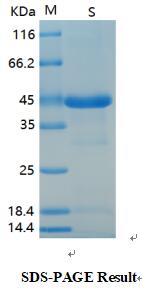Product Name :
CD6 Recombinant Protein Swiss-Prot :
P30203 Host :
E.coli Tag :
≥0.5mg/ml Amino acid Sequence :
HPSPAPPDQLNTSSAESELWEPGERLPVRLTNGSSSCSGTVEVRLEASWEPACGALWDSRAAEAVCRALGCGGAEAASQLAPPTPELPPPPAAGNTSVAANATLAGAPALLCSGAEWRLCEVVEHACRSDGRRARVTCAENRALRLVDGGGACAGRVEMLEHGEWGSVCDDTWDLEDAHVVCRQLGCGWAVQALPGLHFTPGRGPIHRDQVNCSGAEAYLWDCPGLPGQHYCGHKEDAGAVCSEHQSWRLTGGADRCEGQVEVHFRGVWNTVCDSEWYPSEAKVLCQSLGCGTAVERPKGLPHSLSGRMYYSCNGEELTLSNCSWRFNNSNLCSQSLAARVLCSASRSLHNLSTPEVPASVQTVTIESSVTVKIENKESRELML Restriction sites :
NdeI-XhoI Background :
T cell differentiation antigen CD6 is a cell adhesion molecule expressed on immature thymocytes and mature T cells, and has also been detected on a subset of B cells and NK cells within the immune system. CD6 mediates cell-cell interactions through it’s binding partner CD166/ALCAM, and contributes to the formation and maturation of the immunological synapse. CD6 functions as a co-stimulatory receptor, promoting T cell activation and proliferation through the TCR/CD3 complex signaling cascade. Studies have shown CD6 can be glycosylated, hyperphosphorylated on serine and threonine residues, and phosphorylated on tyrosine residues, each of which can differentially effect the function and signaling of this molecule. CD6 also functions as a calcium-dependent pattern receptor that binds and aggregates Gram-positive and Gram-negative bacteria. In response to lipopolysaccharide, CD6 mediates activation of the inflammatory response and secretion of pro-inflammatory cytokines. Soluble :
PBS, 4M Urea, PH7.4 Purification&Purity :
Transferred into competent cells and the supernatant was purified by NI column affinity chromatography and the purity is > 85% (by SDS-PAGE). Storage&Stability :
Store at 4°C short term. Aliquot and store at -20°C long term. Avoid freeze-thaw cycles. Expression vector :
pet-22b(+) BiowMW :
~42kDa Note :
For research use only, not for use in diagnostic procedure. concentration :
≥0.5mg/ml
CD6 Recombinant Protein Swiss-Prot :
P30203 Host :
E.coli Tag :
≥0.5mg/ml Amino acid Sequence :
HPSPAPPDQLNTSSAESELWEPGERLPVRLTNGSSSCSGTVEVRLEASWEPACGALWDSRAAEAVCRALGCGGAEAASQLAPPTPELPPPPAAGNTSVAANATLAGAPALLCSGAEWRLCEVVEHACRSDGRRARVTCAENRALRLVDGGGACAGRVEMLEHGEWGSVCDDTWDLEDAHVVCRQLGCGWAVQALPGLHFTPGRGPIHRDQVNCSGAEAYLWDCPGLPGQHYCGHKEDAGAVCSEHQSWRLTGGADRCEGQVEVHFRGVWNTVCDSEWYPSEAKVLCQSLGCGTAVERPKGLPHSLSGRMYYSCNGEELTLSNCSWRFNNSNLCSQSLAARVLCSASRSLHNLSTPEVPASVQTVTIESSVTVKIENKESRELML Restriction sites :
NdeI-XhoI Background :
T cell differentiation antigen CD6 is a cell adhesion molecule expressed on immature thymocytes and mature T cells, and has also been detected on a subset of B cells and NK cells within the immune system. CD6 mediates cell-cell interactions through it’s binding partner CD166/ALCAM, and contributes to the formation and maturation of the immunological synapse. CD6 functions as a co-stimulatory receptor, promoting T cell activation and proliferation through the TCR/CD3 complex signaling cascade. Studies have shown CD6 can be glycosylated, hyperphosphorylated on serine and threonine residues, and phosphorylated on tyrosine residues, each of which can differentially effect the function and signaling of this molecule. CD6 also functions as a calcium-dependent pattern receptor that binds and aggregates Gram-positive and Gram-negative bacteria. In response to lipopolysaccharide, CD6 mediates activation of the inflammatory response and secretion of pro-inflammatory cytokines. Soluble :
PBS, 4M Urea, PH7.4 Purification&Purity :
Transferred into competent cells and the supernatant was purified by NI column affinity chromatography and the purity is > 85% (by SDS-PAGE). Storage&Stability :
Store at 4°C short term. Aliquot and store at -20°C long term. Avoid freeze-thaw cycles. Expression vector :
pet-22b(+) BiowMW :
~42kDa Note :
For research use only, not for use in diagnostic procedure. concentration :
≥0.5mg/ml
Blocking peptide available as NCP0218P

 CD6 Recombinant Protein
CD6 Recombinant Protein 
 Datasheet
Datasheet COA
COA MSDS
MSDS SHIP
SHIP